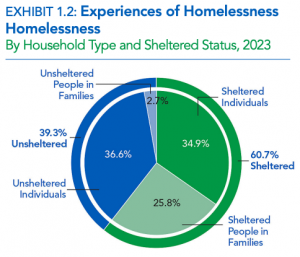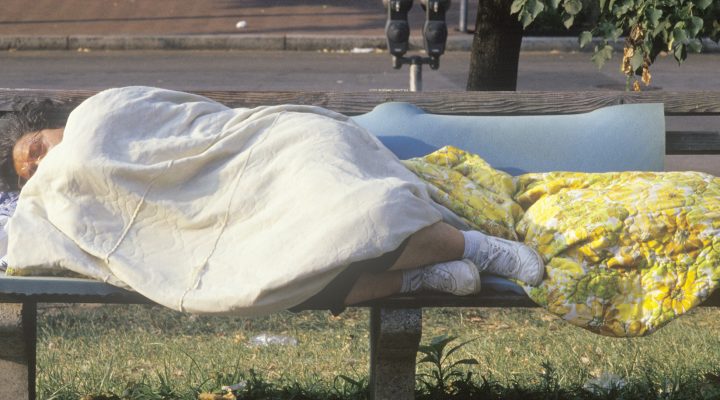Soaring housing costs, rising poverty and the end of COVID-era relief checks and eviction protections contributed to a spike in homelessness in the U.S. last year, according to a study by the U.S. Department of Housing and Urban Development.
More than 653,000 people experienced homelessness in 2023, with 60% in safe haven programs, shelters or transitional housing. The remainder lived in unsheltered spaces not designed for habitation.
“Experiences of homelessness increased nationwide across all household types,” HUD reported. “Between 2022 and 2023, the number of people experiencing homelessness increased by 12%, or roughly 70,650 more people.”
 The number of unhoused individuals documented on a single night was the highest since such tracking began in 2007, the agency explained. “The overall increase reflects the increases in all homeless populations. Homelessness among persons in families with children rose by 16%. Similarly, the rise in individuals experiencing homelessness was 11%.”
The number of unhoused individuals documented on a single night was the highest since such tracking began in 2007, the agency explained. “The overall increase reflects the increases in all homeless populations. Homelessness among persons in families with children rose by 16%. Similarly, the rise in individuals experiencing homelessness was 11%.”
The increase in homelessness coincided with the end of pandemic-related federal funding for shelter beds, which had been provided through the CARES Act and other grants. The expiration of city, county and state-level eviction moratoriums was another contributor, HUD said.
The study underscores the gravity of a June U.S. Supreme Court ruling clearing the way for municipalities to fine and jail people living in unsheltered conditions. The 6-3 decision in Grants Pass v. Johnson backed an Oregon town’s prohibition against sleeping or camping in public spaces even when local shelter space is insufficient or unavailable.
Proponents of the law said it allows authorities to protect public health and safety, while opponents said the ordinance criminalizes the status of homelessness.
“Under the city’s laws, it makes no difference whether the charged defendant is homeless, a backpacker on vacation passing through town, or a student who abandons his dorm room to camp out in protest on the lawn of a municipal building,” Justice Neil Gorsuch wrote for the majority.
But sleep is a biological requirement and should not be punishable with jail time or fines, Justice Sonia Sotomayor wrote in dissent: “For some people, sleeping outside is their only option. The City of Grants Pass jails and fines those people for sleeping anywhere in public at any time, including in their cars, if they use as little as a blanket to keep warm or a rolled-up shirt as a pillow.”
 The high court succumbed to misinformation and stereotypes about homeless people with its ruling, the National Alliance to End Homelessness said July 1.
The high court succumbed to misinformation and stereotypes about homeless people with its ruling, the National Alliance to End Homelessness said July 1.
“Of concern in the majority opinion in this case are the statements that basically repeat the ‘homeless by choice’ contention,” the group explained. “These comments were based on gratuitous statements in amicus briefs in the case, written by people who are looking to cast blame on people other than themselves. The only choice involved in homelessness is the choice by alleged leaders to ignore the housing needs of people with the lowest incomes.”
The green light to criminalize homelessness could have wide demographic consequences. The HUD report found every age, ethnicity and gender orientation present in the national homeless population.
People of color continued to represent a disproportionately large share of the nation’s homeless population, with those who identifying as Black comprising 37% of all unhoused people and half of those experiencing homelessness as part of families with children. Asians and Asian Americans experienced the largest percentage jump among those experiencing homelessness, at 40%, The share was even larger, at 64%, when unsheltered status was considered.
The largest numerical increase in people experiencing homelessness (28%) was among people who identify as Hispanic or Latino, the report says. Hispanics accounted for 55% of the total increase in people experiencing homelessness between 2022 and 2023.
 The study found 35,574 veterans experiencing homelessness, which includes a 14% rise in unsheltered individuals and a 3% increase among those living in sheltered situations. Six in 10 of the population overall were boys or men, and 38% were girls or women.
The study found 35,574 veterans experiencing homelessness, which includes a 14% rise in unsheltered individuals and a 3% increase among those living in sheltered situations. Six in 10 of the population overall were boys or men, and 38% were girls or women.
Also: “People experiencing homelessness who identified as transgender, not singularly female or male, or gender questioning, were more likely to be in unsheltered locations than sheltered locations.”
The study found unaccompanied youth made up 22% of all people under age 25 who are homeless. “California reported the largest number of unaccompanied youth (10,173 people), accounting for more than a fourth of all unaccompanied youth nationally (29%),” it said.
Large numbers of unaccompanied youth also were documented in New York (13% of the national total), Washington (6%), Oregon (4%), Texas (4%) and Florida (4%). Together, these six states account for six of every 10 unaccompanied youth across the country.
Roughly a third of people experiencing homelessness reported enduring chronic patterns of homelessness, representing the highest number in that category since counting began in 2007, the report says. “Two-thirds of individuals experiencing chronic patterns of homelessness, or almost 93,000 people, were counted in unsheltered locations. This is also the highest number recorded.”
Cities with the largest homeless populations included New York City with 88,025, Los Angeles with 71,320, and Seattle, with 14,149. Texas, as a state, rounded out the top 10 with 9,065.
 One major American city where homelessness has been declining is Dallas, where new strategies to create affordable housing are taking root.
One major American city where homelessness has been declining is Dallas, where new strategies to create affordable housing are taking root.
Since 2021, the number of people who are homeless in Dallas has dropped 24%. This is the result of a shift in strategy to provide housing rather than shelters. One of the groups at the forefront of this work is called Housing Forward, which dedicates five people working to find landlords willing to take in tenants who’ve been living unhoused.
It’s hard work, says Sarah Kahn, who leads the agency, but the strategy is simple. “Until we solve the affordable housing crisis, we’re not going to be able to prevent people from flowing into homelessness.”


